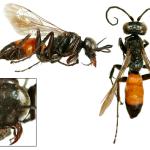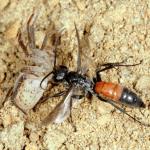A medium-sized, black and red species. It may be identified using Day (1988) and is characterised in the female by having comb-spines on the fore tarsus, a coarse, granular surface to the propodeum and rather long postnotum, and in the male by the subgenital plate which has a short tuft of hairs near the apex. Females of the subgenus Ammosphex Wilcke, to which this species belongs, are amongst the taxonomically most difficult of the family in Europe. Spooner (1941) was the first to correctly associate the females with the males, and earlier published records need to be treated with caution, as recognised by Richards & Hamm (1939).
Widely distributed, occurring in England, Wales, Scotland and Ireland as well as the Channel Islands. Apparently restricted to coastal sites in more northern and western areas.
Overseas, the species occurs in northern and central Europe and in Asia east to Mongolia.
This species is not regarded as being scarce or threatened.
Day, 1988 is the standard work for identifying British Pompilidae. Wiśniowski, B., 2009 is also useful.
It occurs in a range of habitat types and on most soils except perhaps heavy clays.
Probably univoltine; May to September.
A wide range of spiders is collected as prey; Lycosidae (wolf spiders), Clubionidae (foliage spiders) and Thomisidae (crab spiders) have been reliably recorded and perhaps Gnaphosidae (ground spiders) and Agelenidae (cobweb spiders) too (Day, 1988).
The prey is captured first and transported to the nesting location where it is hidden on a plant while the burrow is constructed.
No information is available.
No records have been found.



